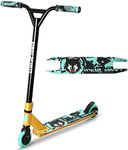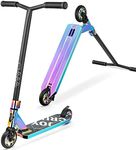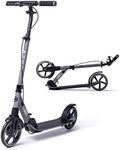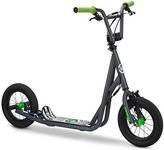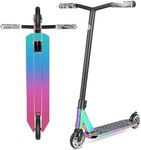Buying Guide for the Best Kids Scooters
Choosing the right kids' scooter can make a big difference in your child's enjoyment and safety. It's important to consider your child's age, skill level, and where they will be riding. By understanding the key features of scooters, you can find one that matches your child's needs and helps them have fun while staying safe.Wheel SizeWheel size refers to the diameter of the scooter's wheels, usually measured in millimeters. This is important because it affects how smooth the ride is and how easy it is to control the scooter. Smaller wheels (around 100-120mm) are lighter and easier for younger kids to handle, making them great for smooth surfaces and short rides. Larger wheels (125mm and above) roll more easily over bumps and cracks, making them better for older kids or for riding on rougher surfaces. To pick the right wheel size, think about your child's age and where they will be riding most often.
Number of WheelsKids' scooters typically come with either two or three wheels. Three-wheeled scooters offer more stability and are ideal for younger children or beginners who are still developing their balance. Two-wheeled scooters are better suited for older kids who have more confidence and coordination. Consider your child's balance and experience when choosing between two or three wheels.
Handlebar HeightHandlebar height is how high the handlebars are from the ground. This is important for comfort and control. Adjustable handlebars allow the scooter to grow with your child, ensuring a comfortable fit over time. Fixed handlebars are set at one height and may only suit a specific age or height range. To choose the right handlebar height, look for a scooter where the handlebars reach about waist height when your child is standing on the deck.
Deck SizeThe deck is the part of the scooter where your child stands. A wider and longer deck provides more space and stability, which is helpful for younger or less experienced riders. Narrower decks are lighter and easier to maneuver, which can be better for older or more skilled kids. Think about your child's shoe size and balance skills when considering deck size.
Weight LimitThe weight limit tells you the maximum weight the scooter can safely support. This is important for safety and durability. Scooters with higher weight limits can be used by older or heavier children, while those with lower limits are designed for younger, lighter kids. Always check the weight limit to make sure the scooter is suitable for your child now and as they grow.
Folding MechanismSome scooters can be folded for easy storage and transport, while others are fixed. Folding scooters are convenient if you need to carry the scooter or store it in small spaces. Fixed scooters are often sturdier but less portable. Consider how you plan to store or transport the scooter when deciding if a folding mechanism is important for you.
Brake TypeScooters usually have either a rear foot brake or a hand brake. Rear foot brakes are common and easy for most kids to use—just step on the back fender to slow down. Hand brakes, similar to those on bicycles, can offer more control but may be harder for younger children to use. Choose a brake type that matches your child's age and coordination.


